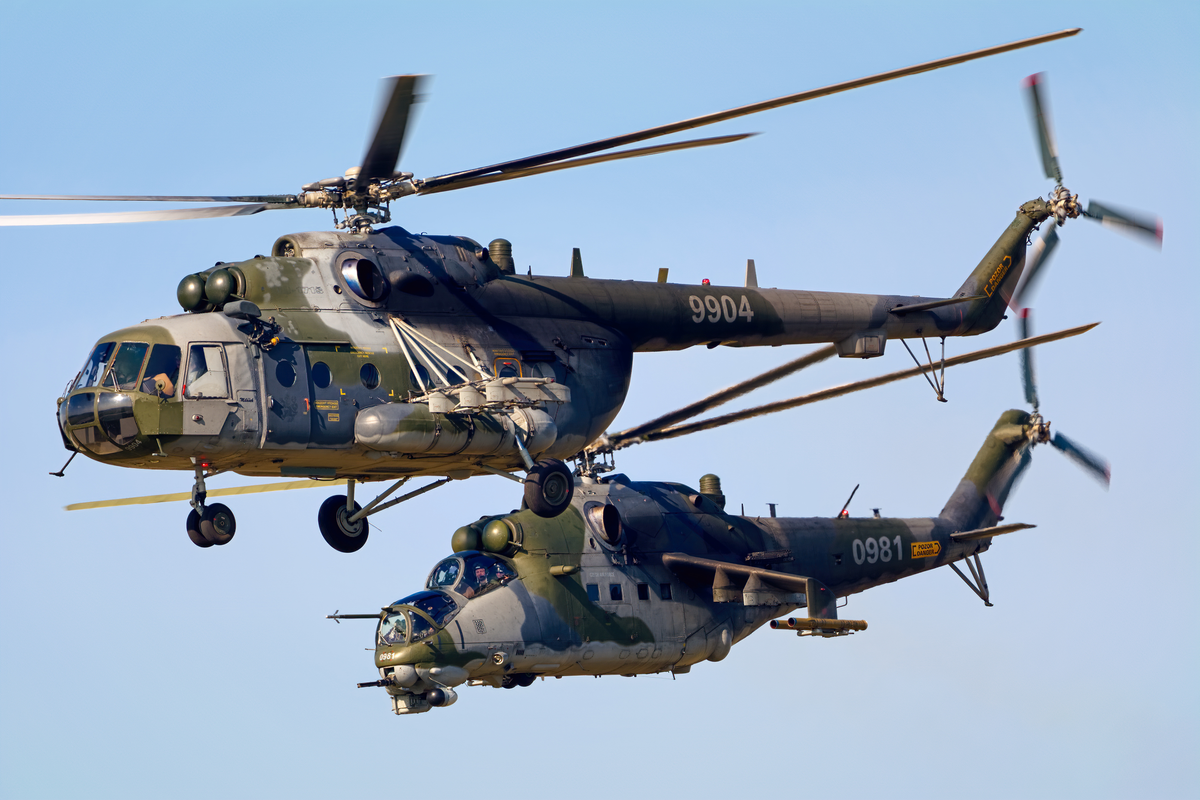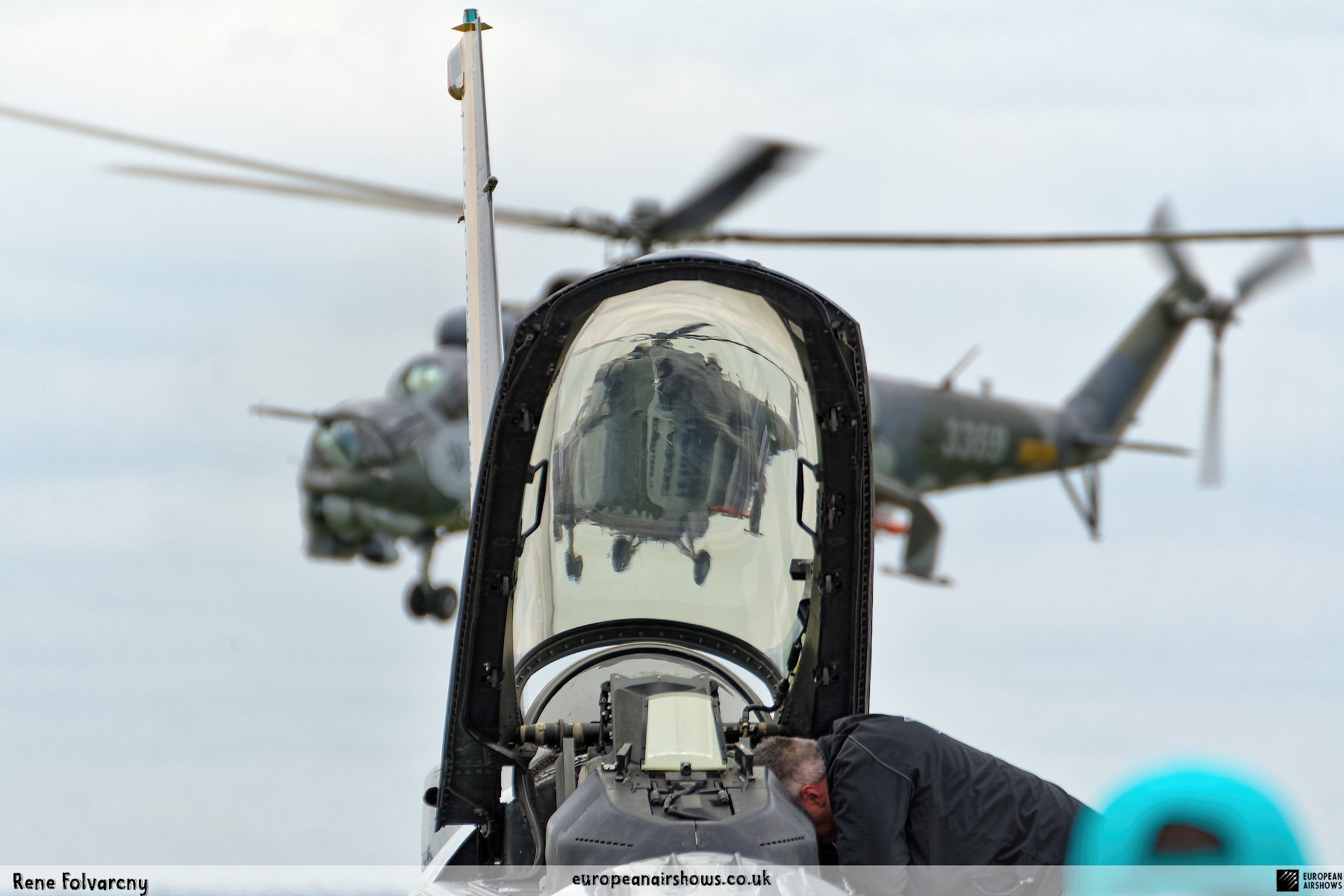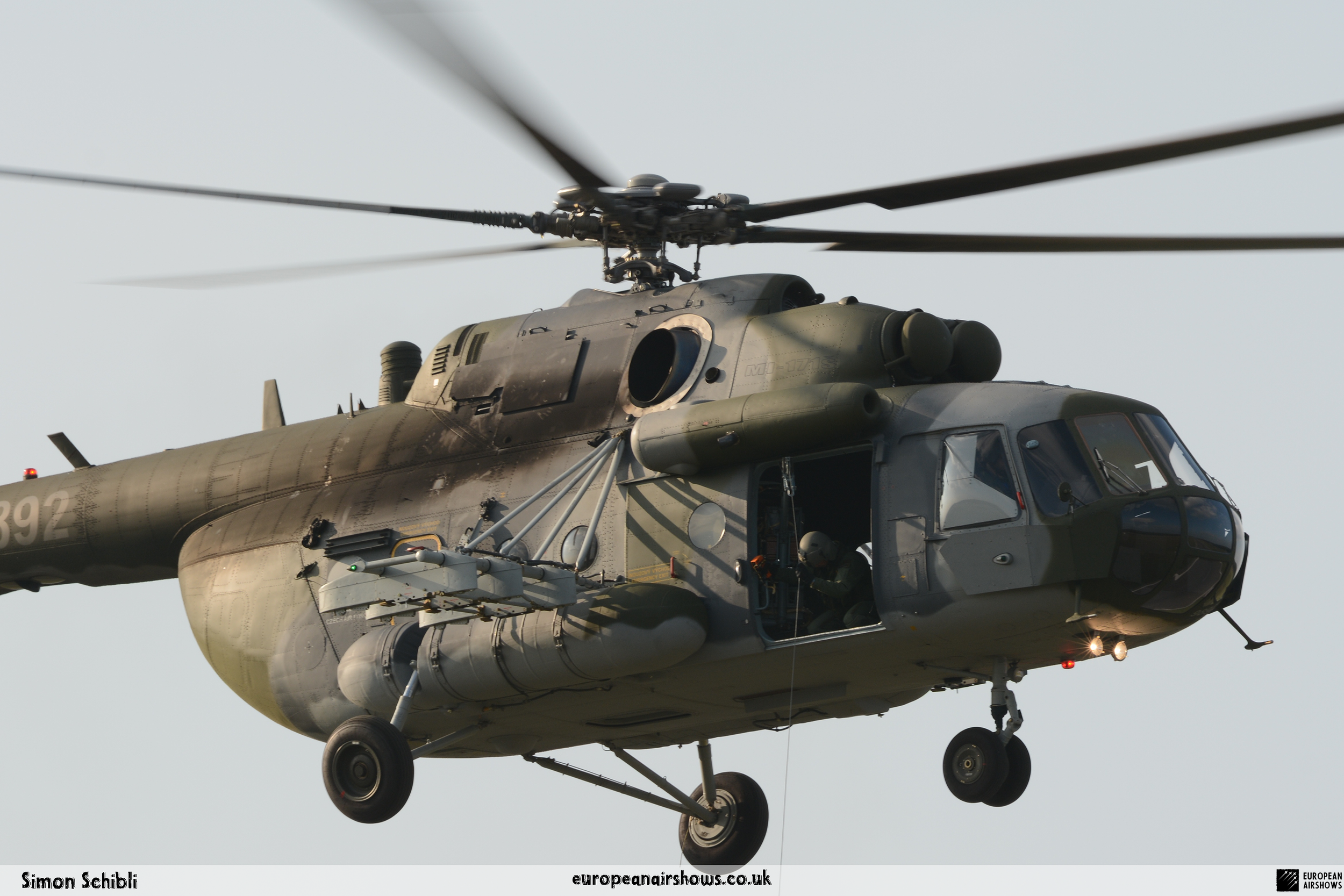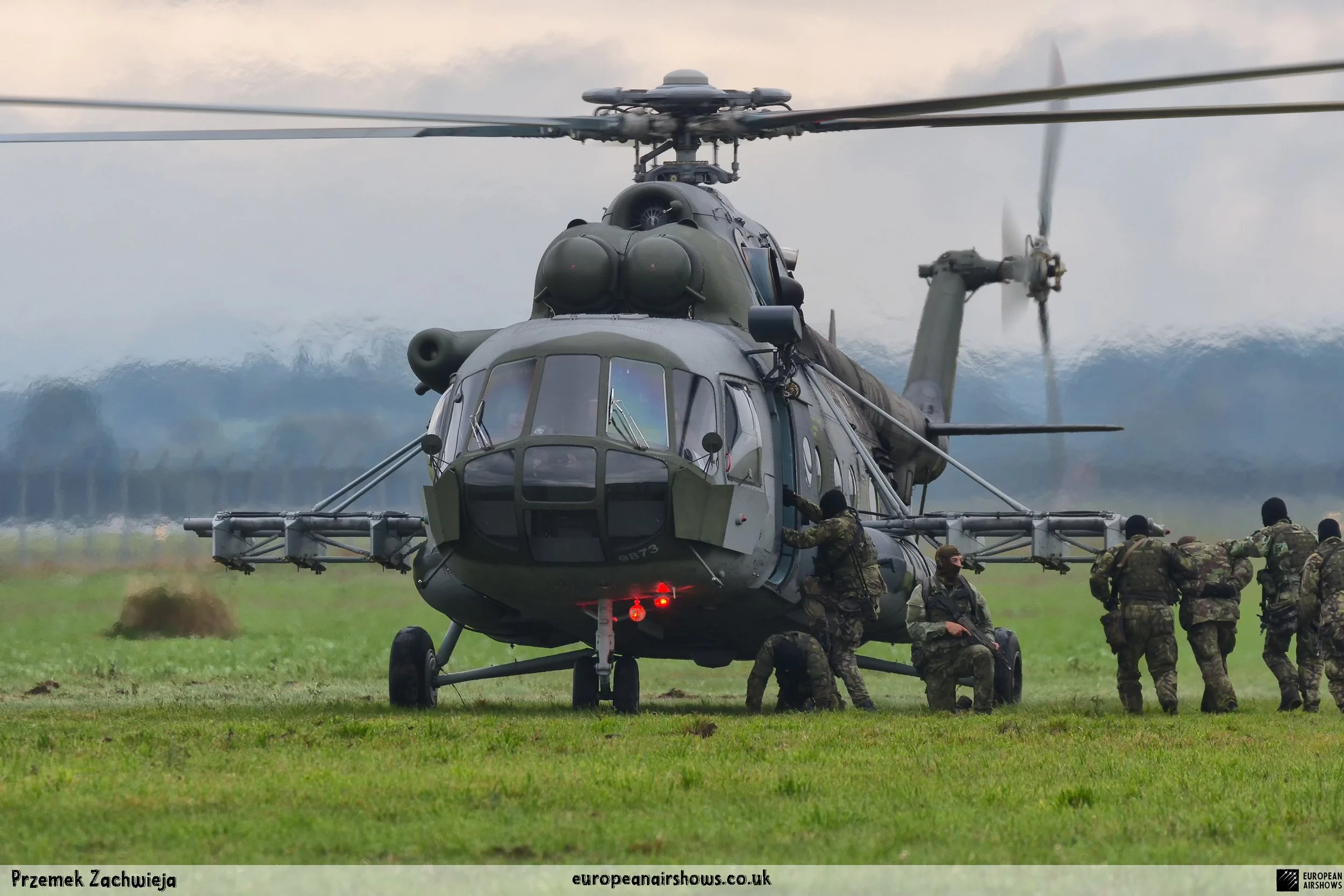
Hind and Hip Battlefield Rescue Demo
About the Aircraft
The Mil Mi-24 and Mi-17/171 helicopter families represent significant advancements in Soviet and Russian aerospace engineering, each serving distinct yet complementary roles within military and civilian operations. The Mi-17, originally introduced in 1975 as part of the Mi-8M series, evolved from the versatile Mi-8 airframe to fulfill the demands of medium twin-turbine transport and armed gunship capabilities. Produced continuously since its inception, the Mi-17 has been manufactured in Kazan and Ulan-Ude, incorporating enhancements such as larger Klimov TV3-117MT engines and improved fuselage structures to accommodate heavier loads. Known for its robustness, the Mi-17 is distinguished by features like a port-side tail rotor and dust shields fronting the engine intakes, making it adaptable to various environmental conditions, including high-altitude and hot climates. Concurrently, the Mi-24, introduced by the Soviet Air Force in 1972, was designed as a large helicopter gunship and low-capacity troop transport, blending fire support with infantry transport capabilities. Often referred to as the “flying tank,” the Mi-24 features armored protection, an integrated weapon system, and the ability to carry up to eight passengers, making it a formidable presence on the battlefield.
Throughout their histories, both the Mi-17 and Mi-24 have undergone numerous modifications and upgrades to enhance their performance, versatility, and survivability. The Mi-17 has seen a wide range of variants tailored for specific roles, including the Mi-171Sh assault version, which incorporates advanced avionics, armor plating, and the capability to deploy anti-tank guided missiles. Licensed production in China and subsequent exports to countries like Venezuela and the Czech Republic underscore the Mi-17’s global footprint and adaptability to diverse operational requirements. Meanwhile, the Mi-24 has evolved through various iterations, from the early Mi-24A models to the more sophisticated Mi-35M variants, which feature upgraded avionics, enhanced weapon systems, and improved countermeasure suites. The Mi-24’s tactical flexibility is further demonstrated by specialized versions such as airborne command posts, electronic warfare platforms, and reconnaissance models, ensuring its continued relevance in modern conflict scenarios.
Both helicopter families have maintained a prominent presence in military and civilian sectors, reflecting their enduring design and operational effectiveness. As of 2021, Russian Helicopters declared the Mi-8/17 the most widely operated helicopter in history, a testament to its extensive use across 58 countries. The Mi-24, despite initial plans to replace it with newer models like the Mi-28 and Ka-52, remains in service due to its proven performance in conflicts such as the Syrian civil war, where upgrades have extended its service life and enhanced its combat capabilities. Continuous production and modernization efforts ensure that both the Mi-17/171 and Mi-24/35 families remain integral components of Russia’s aerial fleet, providing essential support in transport, combat, and specialized missions worldwide.
Team Overview
Number of Aircraft
2
Established
N/A
Based
Namest nad Oslavou Air Base
Aircraft Type
Mi-24V/35 and Mi-171Sh
Mil Mi-24V/35 & Mi-171Sh
The Czech Air Force has long relied on the versatile capabilities of the Mil Mi-24V/Mi-35 and Mi-17/171Sh helicopter families to fulfill a variety of operational roles, ranging from troop transport to armed assault missions. The integration of these helicopters into the Czech fleet began in earnest in the early 2000s, with significant acquisitions made between 2003 and 2005. During this period, sixteen Mi-171Sh helicopters were delivered to the Czech Air Force, marking a strategic enhancement of their aerial capabilities. These helicopters, developed from the Mi-8AMTSh variant, featured substantial modifications tailored to Czech requirements, including the installation of a new large door on the right side, improved Czech-built auxiliary power units (APUs), and the addition of Kevlar armor plates around critical areas such as the cockpit and engines. Furthermore, eight of these helicopters were equipped with loading ramps instead of the traditional clamshell doors, enabling the transportation of vehicles up to the size of an SUV, thereby expanding their utility in both combat and logistical operations.
In parallel with the acquisition of the Mi-17/171Sh series, the Czech Air Force also undertook extensive modernization efforts for their Mi-24V/Mi-35 helicopters between 2003 and 2005. These upgrades included the integration of TV3-117VMA engines, enhanced engine exhaust gas cooling systems (EVU), and comprehensive modifications to the cabin and exterior lighting to support advanced night vision systems. Additionally, the helicopters were fitted with GPS satellite navigation systems, backup artificial horizons, and VARTA batteries to improve reliability and operational effectiveness. A subsequent modernization phase around 2017 further advanced these helicopters by incorporating stabilized FLIR night vision optoelectronic systems, multi-function displays with moving map capabilities, upgraded communication and navigation equipment, and the implementation of a friend-or-foe identification system (IFF). These enhancements not only improved the helicopters’ performance in diverse mission profiles but also ensured their compliance with NATO standards, thereby facilitating seamless interoperability with allied forces.
The culmination of these modernization and acquisition efforts was demonstrated in the Czech Air Force’s decision to donate their upgraded Mi-24V/Mi-35 helicopters to Ukraine in the summer of 2023. This transfer underscored the strategic value and enduring relevance of the Mi-24 and Mi-17 families within the Czech military framework. The donated helicopters, equipped with advanced avionics, defensive systems, and enhanced combat capabilities, are poised to provide significant support in Ukraine’s ongoing defense operations. This move not only reinforced Czech support for Ukraine but also highlighted the robustness and adaptability of the Mi-24V/Mi-35 and Mi-17/171Sh helicopters in addressing contemporary military challenges. As of 2024, the continued production and upgrading of these helicopter families ensure that they remain integral assets for the Czech Air Force and other international operators, maintaining their status as stalwarts of modern aerial warfare and logistics.
Did You Know?
- The CSAR team from Namest nad Oslavou Air Base showcased the synergy between the Mi-24V/Mi-35 Hind and Mi-171Sh Hip helicopters in high-stakes rescue missions.
- In 2023, the Czech Air Force retired its Hind fleet after a final performance at the NATO & Czech Air Force Days in Ostrava, replacing them with Bell AH-1Z Viper helicopters.
- The Mi-171Sh helicopters delivered to the Czech Air Force featured Kevlar armor plates and specialized loading ramps capable of transporting SUVs.
- The retired Hind helicopters from the Czech Air Force were donated to Ukraine to support its aerial defense and combat operations.
- The Czech Air Force’s Hind helicopters were instrumental in providing aerial cover and defensive firepower during CSAR demonstrations.
Test Your Knowledge
1. Which airbase did the Czech Air Force’s CSAR team operate from?
Performer Information
The Czech Air Force has prominently featured the Mil Mi-24V/Mi-35 Hind and the Mil Mi-171Sh Hip helicopters in their Tactical Combat Search and Rescue (CSAR) demonstrations, showcasing a blend of offensive and transport capabilities essential for modern military operations. These demonstrations, conducted by the elite team from Namest nad Oslavou Air Base, highlighted the unique synergy between the Hind, serving as a robust gunship, and the Mi-171Sh, functioning as a versatile tactical transport helicopter. CSAR missions, distinct from traditional search and rescue operations, are executed in active combat zones with the primary objective of locating and recovering downed pilots behind enemy lines under any weather conditions and at any time of day. This demanding environment necessitates helicopters that can perform aggressive extractions while simultaneously providing comprehensive protection and support.
During these CSAR demonstrations, the Hind helicopter played a critical role in providing aerial cover and defensive firepower, effectively shielding the extraction team and repelling potential threats from hostile forces. Equipped with advanced weaponry and avionics, the Hind demonstrated its capability to control the aerial battlefield, ensuring the safe passage of the Mi-171Sh carrying the rescued personnel. The Mi-171Sh, on the other hand, showcased its adaptability and reliability in transporting pilots swiftly and securely from perilous locations to safety zones. This coordinated effort between the Hind and Mi-171Sh underscored the Czech Air Force’s strategic emphasis on integrated aerial operations, enhancing their ability to conduct complex rescue missions with precision and efficiency.
The pinnacle of this collaborative demonstration occurred in 2023 at the NATO & Czech Air Force Days in Ostrava, marking the final performance of the Hind helicopters within the Czech fleet. This high-profile event showcased the advanced CSAR capabilities of the Czech Air Force, emphasizing interoperability with NATO allies and the effectiveness of combined helicopter operations in combat scenarios. Following this demonstration, the Czech Air Force made the strategic decision to retire the Hind fleet, transitioning to the more modern Bell AH-1Z Viper attack helicopters. The AH-1Z Vipers offer enhanced maneuverability, advanced targeting systems, and improved interoperability with NATO forces, aligning with contemporary military standards and operational needs. Subsequently, the retired Hind helicopters were donated to Ukraine, where they continue to serve in bolstering Ukraine’s aerial defense and combat operations. This transition not only signifies the modernization of the Czech Air Force’s helicopter fleet but also extends the operational legacy of the Hind helicopters in supporting allied nations.
Inactive Status
The Mi-24V/35 Hind was retired from the Czech Air Force








































